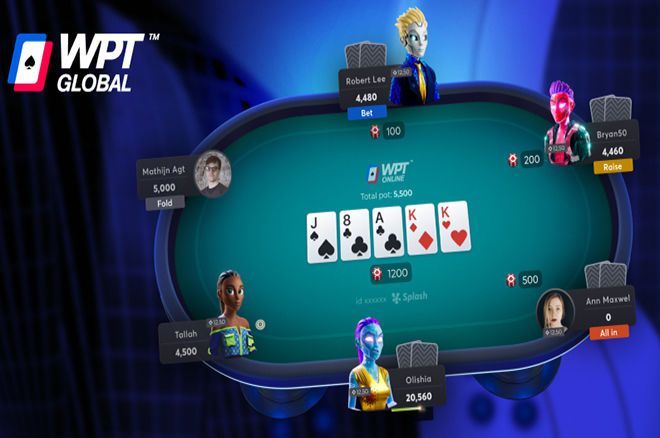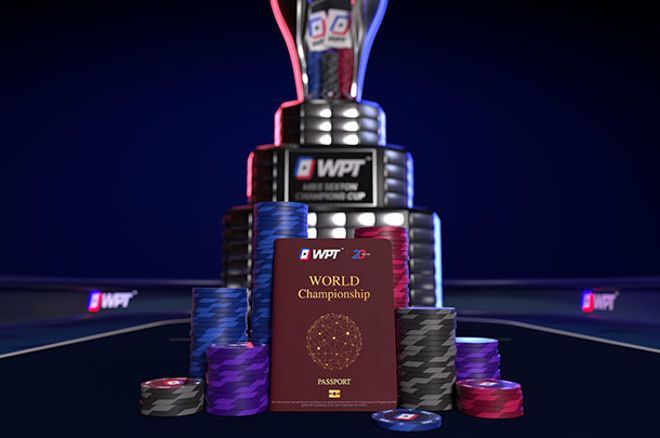WPT Global: How To Learn Texas Hold'em Poker From Scratch

Once you've learned the basic sequence of play in a poker game, there are a few things you should commit to memory as fast as possible. The team at WPT Global, have you covered with a breakdown of the first three things you need to study when learning to play Texas hold'em poker from scratch.
When you first set out to learn the game, it is well worth starting out at low stakes (or even on play money tables). This gives you room to make mistakes without burning through your bankroll. And you will make mistakes to start with. Poker is a complex game that you can always improve at, so don't be embarrassed when you screw up. Instead, focus on learning from your errors, and you'll be an improving player in no time.
When you find yourself winning consistently at your current blind level, only then will it be time to move up in stakes. Here's where to start when getting into poker for the first time.
1. Learn The Basic Hand Rankings
Hand rankings are one of the most fundamental parts of poker. After learning the sequence of play and the rules for betting, the most fundamental thing to memorize is the basic hand rankings. The vast majority of poker variants (including Texas hold'em) use the same basic hand rankings, and those that don't (like short-deck or A-5 lowball) are still easier to lean in relation to the basic rankings.
These rankings are based on how common a given combination of cards is with a five-card hand and a 52-card deck.
List of Poker Hand Rankings In Order
High-Card: A hand with no paired cards, at least two different suits, and no run of five. The weakest hand ranking.
e.g. A?K?Q?J?2?
Pair: Any two cards of the same rank. Better than a high-card hand, but otherwise the weakest hand. The spare cards serve as tie-breakers (aka. kickers if someone else has the same pair at showdown.
e.g. A?A?K?Q?2?
Two Pair: Any two pairs in the same five-card hand. The spare card is the kicker.
e.g. A?A?K?K?2?
Three-of-a-Kind: Three cards of the same rank in your hand. The spare cards act as kickers.
e.g. A?A?A?K?2?
Read More: Exciting Changes Hit WPT Global; PLO Cash Leaderboards Launched & More Multi-tabling
Straight: Any five cards in sequence with at least two suits. Aces can be both low (for an 5?4?3?2?A? straight) or high (for Broadway straight of A?K?Q?J?10?). If two players have a straight, the higher straight always wins.
e.g. 6?5?4?3?2?
Flush: All five cards are of the same suit. The highest card of a flush determines its value (for example A?7?4?3?2? beats K?Q?J?9?7?).
e.g. A?K?Q?J?2?
Full House: A hand made up of a three-of-a-kind with a pair. If there are two full-houses, the higher three-of-a-kind wins. If the two players have the same three-of-a-kind (only possible in some poker variants �� including Texas hold'em) then the pair breaks the tie.
e.g. A?A?A?2?2?
Four-of-a-Kind: Any four cards of the same rank. In the rare case a tie needs to be broken (if the four-of-a-kind is on the board for example), then the player's fifth card acts as a kicker.
e.g. A?A?A?A?2?
Straight Flush: Any sequence of five cards all of the same suit. The highest card of the straight flush determines its value against other straight flushes.
e.g. 6?5?4?3?2?
Royal Flush: A broadway straight flush. The highest possible hand in poker.
e.g. A?K?Q?J?10?
2. Poker Positions at the Table

I poker position has two related meanings, both of which are key to one of the most important aspects of poker strategy.
The first idea is your position relative to the dealer. Broadly speaking, acting last in a betting round is a big advantage. Poker is a game of information, and the last player to act has the most information available to them. This is because when it is time for them to play, the last player knows what everyone else has done during that betting round.
The other related idea, is your position relative to whoever is left in the hand.
At the very start of the hand, being first to act after the blind means the whole table acts after you. However, if you bet and everyone except the blinds fold preflop, then you are acting last for the remaining betting rounds.
It is worth getting a broad understanding of the position as early as possible.
List of the Positions at the Poker Table
These are the positions at a standard nine-handed Texas hold'em table. We will talk about how this changes at tables of other sizes afterward.
Button (Late Position): This is the dealer, who acts last on every street after the flop. This is the best place to be at the start of a hand so you can play a lot more hands from this position.
Small Blind: Immediately to the dealer's left. You are in for half a bet before you even see your cards. Before the flop you are second to last to act, but after the flop, you will always have to go first, placing you at a significant disadvantage.
Big Blind: Immediately to the left of the small blind and two to the left of the dealer. You're in for a full bed before you see your cards.
Under the Gun (UTG): Immediately to the left of the big blind. This is the first player to act preflop. It is still a very early position.
UTG+1, UTG+2: These are the positions to the left of UTG. They mark a transition between early position and middle position. You're still playing pretty tight preflop because of how many players are still left to act after you.
Lojack & Hijack: The lojack (three to the right of the dealer) and hijack (two to the right of the dealer) are considered middle position. You can begin to widen up your preflop hand selection as the number of players to act after you drops.
Cutoff: This is the player to the dealer's immediate right. This player acts second to last after the flop and close to last before it. This is a strong position (second only to the dealer) so weaker starting hands become viable in this spot.
At Different Sized Tables
When the number of players at a table changes, some positions are removed.
The order in which this happens is as follows: for ten-handed to seven-handed tables the positions are adjusted by adding or removing the relevant UTG+X positions, you lose the lojack in six-handed or lower games, lose the hijack in a five-handed game, lose the cut-off when four-handed), and lose UTG when three-handed.
In heads-up play, there are only the big blind and dealer positions. To preserve the preflop sequence of play, the dealer posts the small blind.
Check Our Review of WPT Global's Software and Bonuses
3. Starting Hand Rankings
Preflop strategy is the first thing to get down pat, when you're looking to improve your poker game. However, before you can study that, you need to understand the concept of starting hands.
In Texas hold'em, you get two hole cards before the action starts. This is your starting hand. Because there is no advantage of one suit over another, there are effectively 169 possible two-card combinations that break down into five broad categories.
These categories are important for understanding preflop strategy and so must be learned ASAP. Once you have learned them, you are ready to start digging into more intermediate strategy materials that will explain how to use this information.
Preflop Starting Hands
Although the categories below run very roughly from strongest to weakest, their strength overlaps greatly and can vary depending on the action and position of the hand.
Within each category, a useful simplification is that the higher the ranking of the cards, the better.
Pocket Pairs: This is when both hole cards are of the same rank. AxAx is the best, down to 2x2x.
e.g. A?A?, 10?10?, 2?2?
Suited Connectors: Two cards of that are one rank different and are both the same suit.
e.g. 3?2?, 10?9?, A?K?
Suited Hands: Any two cards of the same suit, but not in sequence.
e.g. A?2?, 10?7?, 6?2?
Offsuit Connectors: Two cards that differ by one rank and are not the same suit.
e.g. A?K?, 10?9?, 3?2?
Offsuit Hands: Two cards of different suits that are not in sequence.
e.g. A?3?, 10?7?, 7?2?
Put Your New Knowledge To The Test On WPT Global

Now that you understand some of the basic concepts of poker, you should put it to practical use. If you load up WPT Global, you can be testing your poker skills out in no time.
The launch of WPT Global means that poker players around the world now also have the chance to win their way to WPT events, win prizes and enjoy exciting games such as Poker Flips. As one of the world's largest cash game poker networks, WPT Global is available in over 50 countries and territories around the world.
WPT Global offers a large deposit match bonus: 100% on deposits up to $1,200 (using any payment method). New players depositing a minimum of $20 automatically receive this match bonus which is unlocked in $5 increments (credited straight to the cashier) for every $20 of rake contribution.
Both tournaments and cash games count towards bonus unlocking; new players have 90 days from the date of the first deposit to unlock and claim their full bonus amount.
In addition to the bonus, you also receive some free tournament tickets depending on the size of your deposit. Check out the table below for more details:
| Players | Deposit No. | Min Deposit | Reward | Total Rewards |
|---|---|---|---|---|
| New only | 1st | $20 | $11 Mini Slam ticket | $11 Mini Slam ticket |
| New and Existing | 2nd | $20 | $11 Mini Slam ticket | 2x $11 Mini Slam tickets |
| New and Existing | Deposit of $300+ | $300 | $110 Sunday Slam ticket | $11 Mini Slam and $110 Sunday Slam ticket |
| New and Existing | Deposit of $1,200+ | $1,200 | 2x $110 Sunday Slam tickets | $11 Mini Slam and 3x $110 Sunday Slam tickets |









